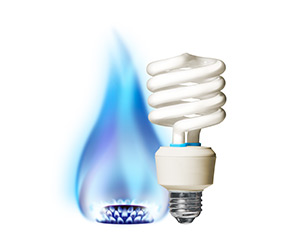As energy prices seem set to continue their upward trend, at least into the foreseeable future, many consumers in the UK are looking for ways to keep their energy costs down. One of the best and most popular options available to energy consumers is the dual fuel tariff. This tariff works in a unique number of ways that helps customers avoid the worst energy price increases. In this article, we will explain what dual fuel is, and why it can help consumers get the best deal on their energy bill compared with other types of tariffs, even in a highly fluctuating energy market.
What is Dual Fuel?
Dual fuel is when both your gas and electricity are provided by the same supplier. If you want to know whether you are already on this tariff, take a look at your most recent energy bill. If it lists both gas and electricity, then you are on this tariff. Alternatively, if you are currently receiving energy bills from two different companies then this likely means that you are getting your gas and electricity supplied by two different suppliers.
Price rises
We all know the cost of energy is going up, but understanding why it is increasing is the key to understanding why dual fuel tariffs are such an attractive alternative to single fuel tariffs. The increased rates in energy prices largely have to do with quickly diminishing levels of gas reserves, especially those coming from the North Sea. As a result, the biggest price increases are largely for gas supplies rather than for electricity, as companies need to look abroad and import extra gas resources in order to make up the shortfall. What this means for you is that if you currently get your gas supplied from a separate provider than your electricity, then the rate you pay for your gas is going to go up much faster than the rate you would pay for electricity.
How does dual fuel help?
Because dual fuel combines both gas and electricity, those rising gas prices tend to be offset by cheaper electricity prices. While a non-fixed tariff that combines both gas and electricity will still rise, the rise will not be as steep as it would be if you were paying for your gas separately from your electricity. Furthermore, energy providers prefer to have customers receive both their gas and electricity from the same provider as it not only means more revenue for that provider, but it also helps cut down on the overhead and inefficiency that having two separate suppliers often entails.
How do I get it?
A misconception exists that to switch from two separate energy providers to just one is more of a hassle than it is worth. The truth is that switching to this tariff is much easier than you may expect. All you need to do is shop around for the cheapest energy company in your area, provide them with your address, contact details, and bank information (if you want direct debit), and they will take care of the rest. For some of the best deals, shop online, where companies providing energy tariffs are currently engaged in a price war to get new dual fuel customers onboard. These online prices will mean that not only will you get the cheapest rates available, but you will also have the option of forgoing paper bill statements and being able to manage all of your energy needs online.
With the UK coming out of one of its longest winters in decades, and gas reserves hitting an all-time low, it is important for consumers to be well aware of what energy options are available to them. Dual fuel energy, because it helps offset the high cost of gas with cheaper electricity, is one of the best ways consumers can help avoid the energy price increases. Far from being a long and complicated process to switch over to, this tariff is actually exceedingly simple to acquire, and having your gas and electricity managed by a single company will also make paying bills month to month much easier as well. To make sure you are not exposed to an increasingly turbulent energy market, your best choice is to switch over your gas and electricity needs to a single energy supplier.
Sam Jones the author advises readers wishing to compare energy tariffs to visit uSwitch.com a price comparison website where all the main providers can be compared.
